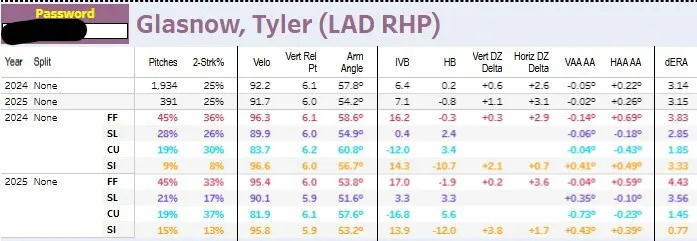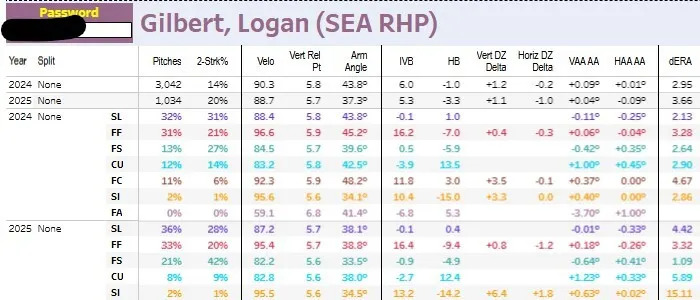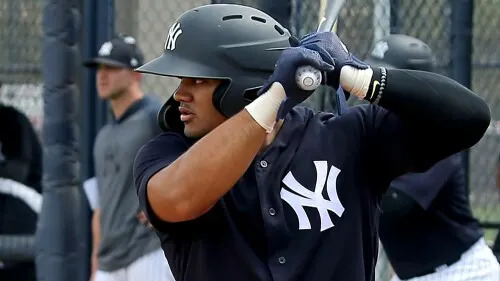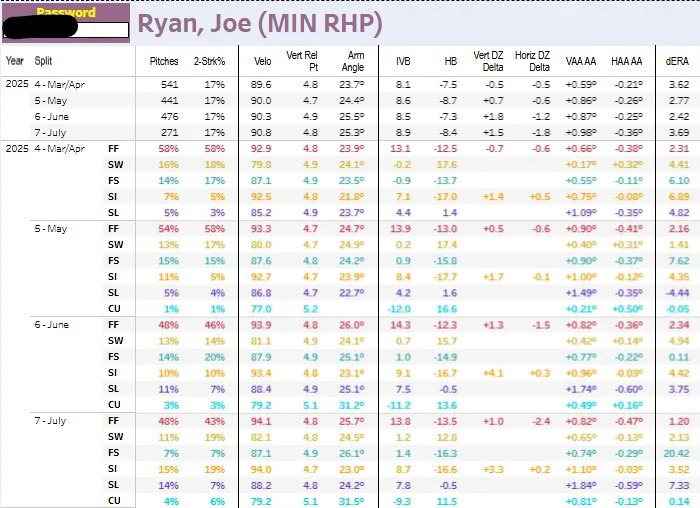It’s Wednesday, which means it’s time for us to visit the bump on Hump Day and discuss starting pitcher news. Each week in this article, I’ll be taking a deeper look at a few trending/surging starting pitchers to see what, if anything, is changing and whether or not we should be investing in this hot stretch.
The article will be similar to the series I ran for a few years called Mixing It Up (previously Pitchers With New Pitches and Should We Care?), where I broke down new pitches to see if there were truly meaningful additions that changed a pitcher’s outlook. Only now, I won’t just look at new pitches, I can also cover velocity bumps, new usage patterns, or new roles. However, the premise will remain the same: trying to determine if the recent results are connected to any meaningful changes that make them worth investing in or if they’re just mirages.
Advertisement
Each week, I’ll try to cover change for at least four starters and give my clear take on whether I would add them, trade for them, or invest fully in their success. Hopefully you’ll find it useful, so let’s get started.
MLB: Cleveland Guardians at New York Yankees
2025 Fantasy Baseball Top 300 update: Aaron Judge tops the rankings, Drake Baldwin soars
Luke Keaschall and Kirby Yates return to the top 300 this week, while David Robertson debuts.
Tyler Glasnow – Los Angeles Dodgers (New Arm Slot, Sinker Usage)
Tyler Glasnow came off the injured list on July 9th and has allowed two runs (one earned) on six hits in 11 innings, while striking out 11 and walking four. The four-seam fastball velocity has been ticking back up over 97 mph, and the whiffs appear to be there, even if the command remains a bit spotty. However, one of the big things I noticed when I went to look at his game logs on the Pitcher List site (thanks to Nick Pollack for the tip) is that Glasnow has really begun to lean into his sinker since returning to the mound.

Tyler Glasnow Sinker Usage
In truth, Glasnow was leaning into the sinker more in the two starts before landing on the injured list, with a 25.6% usage over those four starts. That’s a big increase on the 18% usage he has if you just look at season-long numbers.
Advertisement
So how do we feel about Glasnow throwing the sinker more?
Well, for starters, we have to point out that this is not just an attack plan for right-handed hitters. In the two starts since returning from the break, Glasnow has used the sinker 27.4% of the time to lefties and 26% of the time to righties. Against lefties, he’s using it 50% of the time early in counts and keeping it high in the zone 50% of the time. However, instead of attacking up and away, he’s throwing a lot of inside sinkers, with a 55% inside rate to lefties.
I understand the plan in theory, but Glasnow doesn’t have great command of the sinker. His 45% zone rate against lefties in those two starts is below average, as is his 60% strike rate. However, he has posted a 25% called strike rate and a 10% swinging strike rate (SwStr%) on that pitch to lefties, so perhaps his plan is more about swings and misses and less about inducing weak contact. Glasnow’s sinker is about one mph slower than his four-seam fastball but has nearly 12 inches of arm-side run and just 12.5 inches of induced vertical break (iVB), while his four-seam fastball has only 1.4 inches of arm-side run and nearly 16 inches of iVB. If lefties think they’re getting an inside four-seam fastball but instead get a sinker that runs back over the plate 11 more inches, it could lead to some ugly swings.
Against righties, Glasnow has come off the IL and thrown the sinker 54% of the time early in counts but also used it 23% of the time in two-strike counts and has seen it post a strong 33.3% PutAway Rate, which measures how often a two-strike pitch results in a strikeout. He’s using the sinker all over the strike zone, vertically speaking, to right-handed hitters, but actually keeping it on the outside part of the plate 46% of the time. That’s, again, another strategy that is not as common with a sinker, and I’m not sure it’s working too much with a 7% SwStr% and 15% called strike rate. I’d love to see him get that sinker inside to righties more, but I should note that both of his games since coming off the IL were against the Brewers, who have a lot of left-handed hitters, so this may simply be an attack plan for one team; however, the increased sinker usage is something that we should expect to continue.
Advertisement
One of the consequences has been that it has led to a decrease in curveball usage, which is interesting because it’s one of Glasnow’s best swing-and-miss pitches, with a 17% SwStr% on the season, but he really struggles to command it. Perhaps using the curve less often, and keeping it more to two-strike counts, will help him get ahead of hitters more often. Maybe the curve also puts some strain on his arm. Just something for us to consider.
Another change that I noticed with Glasnow when I looked at Alex Chamberlain’s Pitch Leaderboard is that he has dropped his arm angle almost four degrees. That may not seem like much, but it’s a sizable change and likely why he has gained more horizontal movement on his sinker.

Glasnow Pitch Mix.jpg
Similarly, the lower arm slot has also led to more “rise” on his four-seam fastball and given him a much flatter vertical attack angle. If he gets the command of that pitch back to where we’ve seen it in the past, that could be a nice boost for him. Similarly, his slider has picked up an inch of horizontal movement, likely due to the lower arm angle, but the command of the pitch is off this season, with a 10% lower zone rate, so the pitch has not been as effective.
Advertisement
At the end of the day, Glasnow is still a bit rusty from his injuries, and his command is not where we’d like it to be, but these new changes are interesting. Leaning more into two fastball variations has become the norm in the league, so it’s nice to see Glasnow following suit; however, we’ll have to see if he can rack up as many strikeouts when he uses his curveball less than he has before, and we’ll have to see if he can start jamming those sinkers inside to righties.
Logan Gilbert – Seattle Mariners (New Arm Slot, Splitter Usage/Shape, Cutter Usage)
Heading into the All-Star break, Logan Gilbert seemed on the verge of putting the pieces together after some inconsistent results following his return from the IL. I ranked him as my 8th overall starting pitcher in my updated rankings and said, “Gilbert has battled injury this season and has a 3.39 ERA in his 61 innings. That being said, his K-BB% and his SIERA are second-best of any starting pitcher in baseball with at least 30 innings pitched this season. We know how talented Gilbert is when he’s healthy, so I’m just betting on Gilbert “figuring it out” over the final two-plus months.”
Well, the figuring it out might have started on Tuesday, when he threw 6.1 scoreless against the Brewers, allowing two hits and no walks while striking out 10. It was a fastball-dominant showing from Gilbert, who was able to get 72% strikes on the pitch and then induce six whiffs on his slider and another seven whiffs on his splitter. It was also another start where Gilbert seemed to be paring down his arsenal.

Logan Gilbert changes.jpg
As you can see from Alex Chamberlain’s Pitch Leaderboard above, Gilbert came into this season and scrapped the cutter that he used 11% of the time last season. Over the last few starts, he has also rarely thrown his sinker. He threw it 12 times in his first start off the IL on June 16th and then has thrown it just six times TOTAL in his last six starts, including none on Tuesday. That means we’re looking at a four-pitch mix for Gilbert now instead of a six-pitch mix.
Advertisement
Getting rid of the cutter isn’t a bad idea for Gilbert. Last season, he used the pitch 7% of the time against right-handed batters and 14% of the time against left-handed batters. Overall, it was a pitch he commanded in the zone well and induced above-average swinging strike rates on, but it did give up a 45% ICR that was a 29th percentile rate in baseball. The pitch was more effective for him against lefties, even though it gave up more hard contact, so if he was going to get rid of it, he needed a clear plan to attack lefties.
That plan seems to be leaning on his splitter more often. Gilbert’s splitter usage is up to 21% on the season from 13% last year, and his usage to lefties specifically is up to 20.6% after being at 14.5% last year. We’ve also seen a slight change to the shape and velocity of his splitter. This year, the pitch is over two mph slower with less horizontal break across the plate and almost two inches more drop. Essentially, it’s moving down and away from lefties more often, which we like to see.
As a result, the splitter has been downright nasty this year against lefties, posting a 34% SwStr% and .056 batting average allowed. It has also not allowed a single barrel or batted ball that qualifies as Ideal Contact on 111 pitches to lefties this season. Gilbert is using the pitch 72% of the time in two-strike counts to lefties, with a 31% PutAway Rate, which is a clear improvement from his 59% usage in two-strike counts to lefties last year and 22% PutAway Rate.
The final change for Gilbert, which may also be connected to the shape change on his splitter, is that Gilbert has dropped his arm angle by over six degrees. Now, we could say that’s him compensating for his injury, but considering the arm angle change has remained even after he’s come back healthy, I think it’s a conscious decision. We’ve seen many pitchers drop their arm angle to a more comfortable slot this year, and if Gilbert has gotten rid of his cutter, then he has one less pitch that he needs to stay on top of. He might simply be pitching from a more natural arm angle.
Advertisement
However, there have been a few consequences. He now has a lower arm slot but the same iVB on his fastball, which has led to an even flatter fastball with a higher adjusted vertical approach angle. His locations have been getting better in his starts since coming off the IL, and the fastball is starting to play up a little more. I would just like to see him get it up in the zone more often. He also has minor movement changes on his other pitches, but has seen a better overall strike rate this year and the best first pitch strike rate of his career, so perhaps the arm slot is helping him with that command and control.
All said, we know Gilbert is talented, so his figuring it out is not a surprise, but it’s nice to see that paring down his arsenal is actually working for him. Having that slider, four-seam, and splitter to lefties has been enough for him, so he doesn’t miss the cutter and can focus on his better pitches.

nbcs_edgefantasy_JassonDominguezCTB_210604.jpg
2025 Fantasy Baseball: 60 Undervalued Players, from Jasson Domínguez to Bo Bichette
Advertisement
60 undervalued players to help you win your fantasy league.
Joe Ryan – Minnesota Twins (New Curveball, Splitter Usage, Sinker Usage)
Nine starts ago, Joe Ryan threw a curveball in a game for the first time since 2022. He only threw one, and then in his next start, he also only threw one. However, that usage has started to tick up a bit in recent outings, with a 5.4% usage over his last seven starts, and even a 9.1% usage in his last start.

Ryan last start.jpg
Over those seven starts, Ryan has been electric, with a 2.08 ERA, 0.85 WHIP, and 50/8 K/BB ratio. That’s a pretty impressive line considering Ryan has yet to establish a clear secondary pitch behind his four-seam fastball. At some points, it’s been the sweeper or the splitter, and now it’s been the sinker with the curve creeping up in usage.
Advertisement
So how is this new curveball usage working for Ryan?
He’s using it to both righties and lefties, with a 5% usage to lefties over seven starts and a 6% usage to righties. Lefties get it primarily as an early in the count strike pitch, with a 64.3% early usage, while righties see the curve 57% of the time in two-strike counts. It has just a 16.7% PutAway Rate to righties, so it hasn’t been super successful in those counts, but it does have a 28.6% SwStr% in a small sample size against righties, so maybe it will work in the long run. He has better-than-league-average zone rates and strike rates on the curveball to lefties, so it works as a strike pitch there, even if it has been getting hit hard at times.
The introduction of the curveball has maybe taken some of the emphasis away from the splitter, which Ryan has thrown only 8% of the time over his last seven starts, with a 13% usage to lefties. Before that June 14th start, Ryan was throwing the splitter 15.4% of the time overall in 13 starts, but 23.3% of the time to lefties, so that’s a 10% decrease in usage.

Joe Ryan Mix.jpg
It’s a change you can start to understand when you see that, against lefties specifically, Ryan’s splitter had a 7% worse zone rate than last year, 10% worse strike rate, 3% worse SwStr%, and allowed a 6% higher ICR. Essentially, everything about the splitter to lefties was worse this season than it was last season. It wasn’t a bad pitch, but it was a fairly mediocre one.
Advertisement
Ryan has instead turned to the slider more against lefties over his last seven starts, and while it also doesn’t miss many bats, he can command it in the zone better, and it’s allowed just an 8.3% ICR to lefties on the season. If you look at just these last seven starts, Ryan has begun using the slider and curve early in the count to lefties while using the splitter and four-seam more in two-strike counts. That has allowed the four-seam to play up and post a 23% PutAway Rate to lefties over the last seven starts, up from 19% in his first 13 starts.
The final change is that he has increased his sinker usage recently. In his first 13 starts, he used it 9.7% of the time overall and 14.3% of the time to righties. That has changed to a 12.7% usage overall and 16% usage to righties and shifted even more in his last five starts, where he has a 15.3% sinker usage overall and 22% to righties. Over those five starts, the sinker is his second most-used pitch to tighies, with the slider and sweeper both sitting around 13% usage.
He uses the sinker early in the count to righties and likes to keep it low and mostly out over the plate. Ryan has been able to pound the zone with the sinker, with strong zone rates and strikes over the last seven starts, and very little hard contact allowed. He will mix the pitch in with two strikes, and it does have a 26% PutAway Rate to righties over the last five starts, probably because most righties are expecting his four-seam and get a pitch that has five inches more run and significantly less “rise” as it approaches the plate, so hitters swing over it.
I don’t believe these changes make him a drastically different pitcher, but I do think changing his approach against lefties was a smart decision. Ryan is still searching for a legit secondary weapon, and it’s scary to think of how good he might be if he were actually able to find one. Until then, he remains a fringe top-ten starter in fantasy baseball, which isn’t so bad.
Advertisement
Brandon Pfaadt – Arizona Diamondbacks (Cutter Usage)
We’ve seen Brandon Pfaadt do this before. He adds in a new pitch or changes his pitch mix for a time and goes on a strong stretch of production, only to falter and start searching for a new plan. We saw it earlier this year with his curveball usage, and then, after I covered his struggles in early June, we’re now seeing it again with the introduction of a cutter.

Pfaadt Mix Change.jpg
In his June 17th start in Toronto, Pfaadt unveiled his cutter for the first time. He threw just four of them, and we weren’t sure if it was a real change or a misclassification or just him experimenting. He threw five in his next start in Coors and then bumped that up to 11 cutters when he returned home to face the Marlins. Since he introduced the cutter into his pitch mix, he’s registered a 3.50 ERA, 0.94 WHIP, and 35/5 K/BB ratio in 36 innings. That’s also been against some decent offenses like the Blue Jays, Padres, Giants, and Cardinals, and also one start in Coors Field. All in all, not bad. But will it stick this time?
Advertisement
In those six games, he has thrown 57 cutters, and only eight have been to righties, so this is certainly a plan to attack lefties. Much like the early-season increase in curveball usage was designed to do. He’s using the cutter 71.4% of the time early in counts to lefties, and the few times he does throw it in two-strike counts, it’s not often leading to strikeouts. He has a 51% zone rate on the pitch against lefties, which is essentially league average, but has a 91st percentile strike rate.
It also allows a 94% contact rate with just a 4% SwStr%, so this is by no means a swing and miss pitch. This is a pitch that thrives on inducing weak contact, and gets it with just a 6.3% ICR allowed. A lot of that has to do with how well he’s able to jam lefties inside, with an 80% inside rate against lefties and 72% of those cutters coming either middle-in and up-and-in. That’s a strategy that can work and has been working for Pfaadt.
Part of the reason it’s working is because Pfaadt’s four-seamer has been pretty bad this season, so he needs to start throwing it less. On the year, the four-seamer has just an 8.2% SwStr% with a 53% ICR and 19% barrel rate allowed. Both lefties and righties have hit his four-seamer hard, and he has struggled to command it in the zone against both as well. Pfaadt has leaned into his sinker as his primary fastball against righties, with his sweeper being his most-used pitch overall to them, and he’s now turning to the cutter more against lefties while also mixing in the sinker, changeup, and four-seam.
Against lefties overall since adding in the cutter, Pfaadt is allowing a .179 average and .305 xwOBA with just a 30% ICR. He does have just a 6.4% SwStr% and 17% strikeout rate against them, but as long as lefties aren’t crushing Pfaadt, this can help because his sweeper allows him to post a 30% strikeout rate to righties. Overall, I still think Pfaadt, even with these changes, is just a 23-25% strikeout rate pitcher who will have an ERA around 3.70 or higher, but that will play as a low-upside option in shallow formats and a solid back-end starter in deeper formats.
